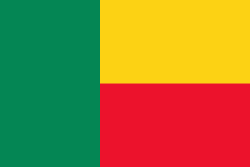Kétou (Commune of Ketou)
Kétou is a Yoruba town, arrondissement, and commune located in the Plateau Department of the Republic of Benin (previously called Dahomey). The commune covers an area of 2183 square kilometres and as of 2013 had a population of 156,497 people, making it the 13th largest settlement in Benin.
Kétou (Ketu) is said to have been founded by Ede, son of Sopasan and grandson of Oduduwa (also known as Odudua, Oòdua and Eleduwa), who ruled the Yoruba kingdom of Ile-Ife (also known as Ife) in present-day Nigeria. The oba (meaning 'king' or 'ruler' in the Yoruba language) is referred to as the Alaketu of Ketu.
Most Gbe speaking people (Ewe, Adja, Fon,and Phera) trace their origins to Ketou. According to their oral history, Ketou was originally known as Ketume ( in the sand). Alternatively, they also refer to Ketou as Amedzorfe ( place of human origin). They were displaced by the Yoruba because the Yoruba had larger population and access to horses / cavalry from the north. Ketu North and Ketu South administrative districts in the Volta region of Ghana are named in remembrance of their origins from Ketou in Benin.The indigenes of these two districts are mainly Ewes.
Kétou (Ketu) is said to have been founded by Ede, son of Sopasan and grandson of Oduduwa (also known as Odudua, Oòdua and Eleduwa), who ruled the Yoruba kingdom of Ile-Ife (also known as Ife) in present-day Nigeria. The oba (meaning 'king' or 'ruler' in the Yoruba language) is referred to as the Alaketu of Ketu.
Most Gbe speaking people (Ewe, Adja, Fon,and Phera) trace their origins to Ketou. According to their oral history, Ketou was originally known as Ketume ( in the sand). Alternatively, they also refer to Ketou as Amedzorfe ( place of human origin). They were displaced by the Yoruba because the Yoruba had larger population and access to horses / cavalry from the north. Ketu North and Ketu South administrative districts in the Volta region of Ghana are named in remembrance of their origins from Ketou in Benin.The indigenes of these two districts are mainly Ewes.
Map - Kétou (Commune of Ketou)
Map
Country - Benin
 |
 |
| Flag of Benin | |
From the 17th to the 19th century, political entities in the area included the Kingdom of Dahomey, the city-state of Porto-Novo, and other states to the north. This region was referred to as the Slave Coast from the early 17th century due to the high number of people who were sold and trafficked during the Atlantic slave trade to the New World. France took over the territory in 1894, incorporating it into French West Africa as French Dahomey. In 1960, Dahomey gained full independence from France. As a sovereign state, Benin has had democratic governments, military coups, and military governments. A self-described Marxist–Leninist state called the People's Republic of Benin existed between 1975 and 1990. In 1991, it was replaced by the multi-party Republic of Benin.
Currency / Language
| ISO | Currency | Symbol | Significant figures |
|---|---|---|---|
| XOF | West African CFA franc | Fr | 0 |
| ISO | Language |
|---|---|
| FR | French language |















